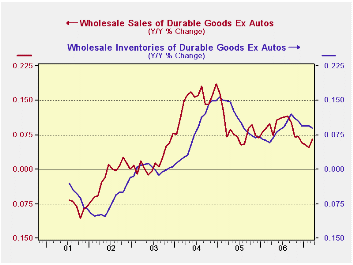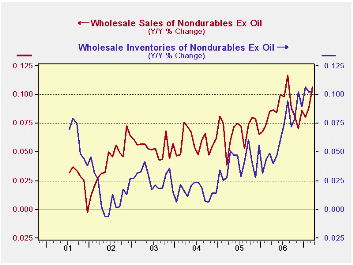 Global| May 08 2007
Global| May 08 2007U.S. Wholesale Inventories & Sales: No Bad News
Summary
Inventories are tricky to analyze. We plot durables excluding autos and nondurables excluding oil to get at the trends outside these two sectors. When we do we find inventory and sales growth are coming into better balance. Durables [...]

Inventories are tricky to analyze. We plot durables excluding autos and nondurables excluding oil to get at the trends outside these two sectors. When we do we find inventory and sales growth are coming into better balance.
Durables inventory growth still exceeds sales growth; inventory and sales growth trends have come together for nondurables.
The two charts show the evolution of the trends on relatively smooth year-over-year percent changes but the table below shows more time horizons.
Here we see that sales growth has surpassed inventory growth for durables and nondurables over three months and six months when oil and autos are excluded, respectively. Indeed, most categories show that sales growth has overtaken inventory growth and I:S ratios are receding. Still, at the far right we show where I:S ratios stand relative to their range of values since 1998; we see that most sectors have ratios that are still high in their range. So although sales are starting to grow faster than inventories, inventories are still plentiful relative to the pace of sales according to historic standards (last nine years).
This is an encouraging sign that inventory liquidation is not called for. Firms do not even need to slow the pace of inventory accumulation since sales growth exceeds inventory growth. But sales are not yet that much stronger than inventories across the board for wholesalers. Petroleum, autos and computers are still building stocks faster than they are growing sales in the recent three months. And, since stocks generally are still high relative to sales this report is no clarion call for inventory rebuilding. That is still a ways off.
This report is more notable for its lack of bad news than for the presence of good news.
| All growth rates annualized | Inventory-&-Sales Trends: Wholesalers | I:S ratio Percent of |
|||||
| 2007 Mar | 3-mos | 6-mos | 12-mos | Range | |||
| Sales | Inventories | Sales | Inventories | Sales | Inventories | 1998-date | |
| All Wholesaling | 7.7% | 5.3% | 7.7% | 4.6% | 8.4% | 8.1% | 7.0% |
| Durables | 3.3% | 3.3% | 5.1% | 2.4% | 6.6% | 7.6% | 18.3% |
| Durables less autos | 7.9% | 3.8% | 4.2% | 3.5% | 6.6% | 9.0% | 25.2% |
| Autos | -16.3% | 0.6% | 9.8% | -3.3% | 6.8% | 0.7% | 7.0% |
| Computers | 2.3% | 4.8% | 10.8% | 1.7% | 10.9% | 6.0% | 0.9% |
| Machinery | 16.6% | 5.6% | 6.1% | 5.2% | 8.1% | 9.1% | 28.7% |
| Other Durables | 6.4% | 2.9% | 2.6% | 2.9% | 5.5% | 9.2% | 28.7% |
| Nondurables | 12.1% | 9.0% | 10.2% | 8.6% | 10.1% | 9.0% | 5.2% |
| Nondurables less Petrol | 17.5% | 9.7% | 10.6% | 10.5% | 10.7% | 10.2% | 6.1% |
| Petroleum | -5.9% | 1.8% | 8.6% | -9.4% | 8.0% | -2.8% | 44.3% |
| Groceries | 28.9% | 27.2% | 18.3% | 18.0% | 14.8% | 16.9% | 57.4% |
| Other Nondurables | 13.0% | 5.7% | 7.6% | 8.7% | 9.0% | 8.7% | 7.8% |
| Percentage of range Low Percent reflect high standing (ie top 1% or bottom 99th percentile) | |||||||
Robert Brusca
AuthorMore in Author Profile »Robert A. Brusca is Chief Economist of Fact and Opinion Economics, a consulting firm he founded in Manhattan. He has been an economist on Wall Street for over 25 years. He has visited central banking and large institutional clients in over 30 countries in his career as an economist. Mr. Brusca was a Divisional Research Chief at the Federal Reserve Bank of NY (Chief of the International Financial markets Division), a Fed Watcher at Irving Trust and Chief Economist at Nikko Securities International. He is widely quoted and appears in various media. Mr. Brusca holds an MA and Ph.D. in economics from Michigan State University and a BA in Economics from the University of Michigan. His research pursues his strong interests in non aligned policy economics as well as international economics. FAO Economics’ research targets investors to assist them in making better investment decisions in stocks, bonds and in a variety of international assets. The company does not manage money and has no conflicts in giving economic advice.






